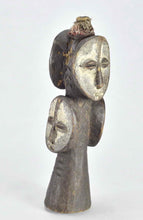MC1873 "Mr. Many Heads" LEGA Statue Sakimatwematwe Figure
Regular price
€895.00
Sale
“Mr. Many Heads saw an elephant on the opposite bank of the Lwalaba”
This is the aphorism linked to the multi-headed wooden figurines Sakimatwematwe,
which symbolize the knowledge and clairvoyance of the initiates of the highest rank of Bwami (klutombo lwa kindi)
The initiate of the supreme grade sees in all directions, and perceives what is unknown and invisible to ordinary mortals.
"He applies his sense of justice as an arbiter between the young and the old, men and women, initiates and non-initiates, good and evil (Biebuyck, 1986, p. 86; and 2002, p. 126). Surpassing the moral codes individually conveyed by the other characters, Sakimatwematwe single-handedly sums up the power and wisdom of the initiate of the supreme grade: "master of the forest world" (nenelubanda); "main beam of a house" (1994, p. 33)" (Marguerite de Sabran, SAKIMATWEMATWE: The Face of Knowledge) in Arts of Africa and Oceania, Sotheby's catalogue, 14 Dec 2016, Paris)
According to Alexandre Safiannikoff, these very rare statues are called
Sabitwebitwe in Kalole, Pangi and Shabunda areas
Shakungukungu in Kituu and Mwenga areas
Sakimatwematwe among the Bembe and in the bordering Lega areas
Biebuyck, Ethics and Beauty p126
Biebuyck Lega culture fig 86
Safiannikoff, p70
The statuettes used in the context of the Bwami cult are generically called Iginga
Collective, sacred properties, they are kept secret, generally in closed wicker baskets. Their use is reserved, with some exceptions, for passages to the upper (Yananio) and supreme (Kindi) levels.
The Bwami is a hierarchical association by ranks which organizes the social structure and ensures the stability of the Lega community.
Each level passage gives rise to initiation rites where one speaks, sings, dances, mimes and exposes. A multitude of aphorisms are used during the stories and songs
" The aim is to formulate and interpret in multiple symbolic ways the principles, moral and philosophical values and rules of the Bwami, to each and to inculcate them, and to grant the initiates the paraphernalia relevant to their level of grade as well as their symbolic references, and to transmit the power, prestige and privileges that result from it " (Biebuyck, Sculptures don't speak 2010)
- Lega Jewels from the Benoît Rousseau Collection. Viviane Baeke, MRAC and Benoît Rousseau. 2013. BRUNEAF.
- The Lega and their art. In the footsteps of a dreamer lost in Congoland Emile-Alexandre Georges. 2005. Royal Museum for Central Africa.
- Treasures of Africa, Tervuren Museum, collective work, MRAC, 1995
(Notes by Daniel P. Biebuyck)
CONGO DRC
TYPE OF OBJECT: Figure, statue, figurine.
Please have a look on the pictures.











